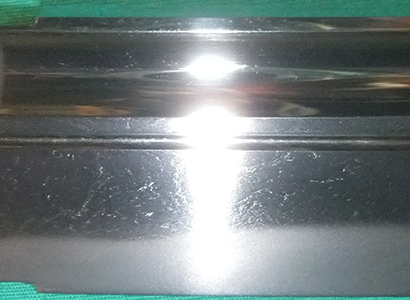Katana O-suriage
Blade length 62.8cm, thickness at the base 8mm, width 3.2cm
This is a nice katana with a long kissaki and attractive appearance. It looks typical katana blade what is shortened from a long tachi blade of 14th century. It has no fumbari on both width and thickness.
Steel has a visible wood grain layer pattern. And it is filled with large steel particles. It looks beautiful.

Hamon is made of large particles. It is bright. And its temper line (hamon particle band) is wide. Many attractive activities appear around the temper line. Those are kinsuji, sunagashi, and some others. And a lot of faint ashi in the hamon. Hamon in kissaki also has a lot of large particles with sweeping pattern.
Yubashiri and utsuri also appear in the ji.
The polishing is the modern style. The work is good. The hadori work is rather strong, though. But you can study the hamon by proper lighting.
The total taste of this blade easily reminds us so-called "Soshu tradition". And by careful studying, you can find that the steel is a little dark or black (opposite meaning of fine or clear). We can easily find it is a nice blade shortened from a long tachi blade of 14th century. However, it is difficult to find out a reasonable attribution to this blade for our eyes. On the other hand, we also wonder if it is possible to consider it to a copy of O-suriage blade by some master smith in 17th century, for example Kunihiro or Yasutsugu. In that case, it could be another "Yamamba-giri".
Tang
The blade is so much shortened as its original tang has completely cut off. We are not sure if the grooves are original or not.
Habaki is double, made of solid gold. However the gold is alloyed with silver. So the color is a little whitish. We don't know what family the mark on it suggests to.
Shirasaya and bag
It is not very easy for us to find out the smith who made this. It is a nice blade, though. It may be an interesting journey to detect the smith or school researching books and other information.